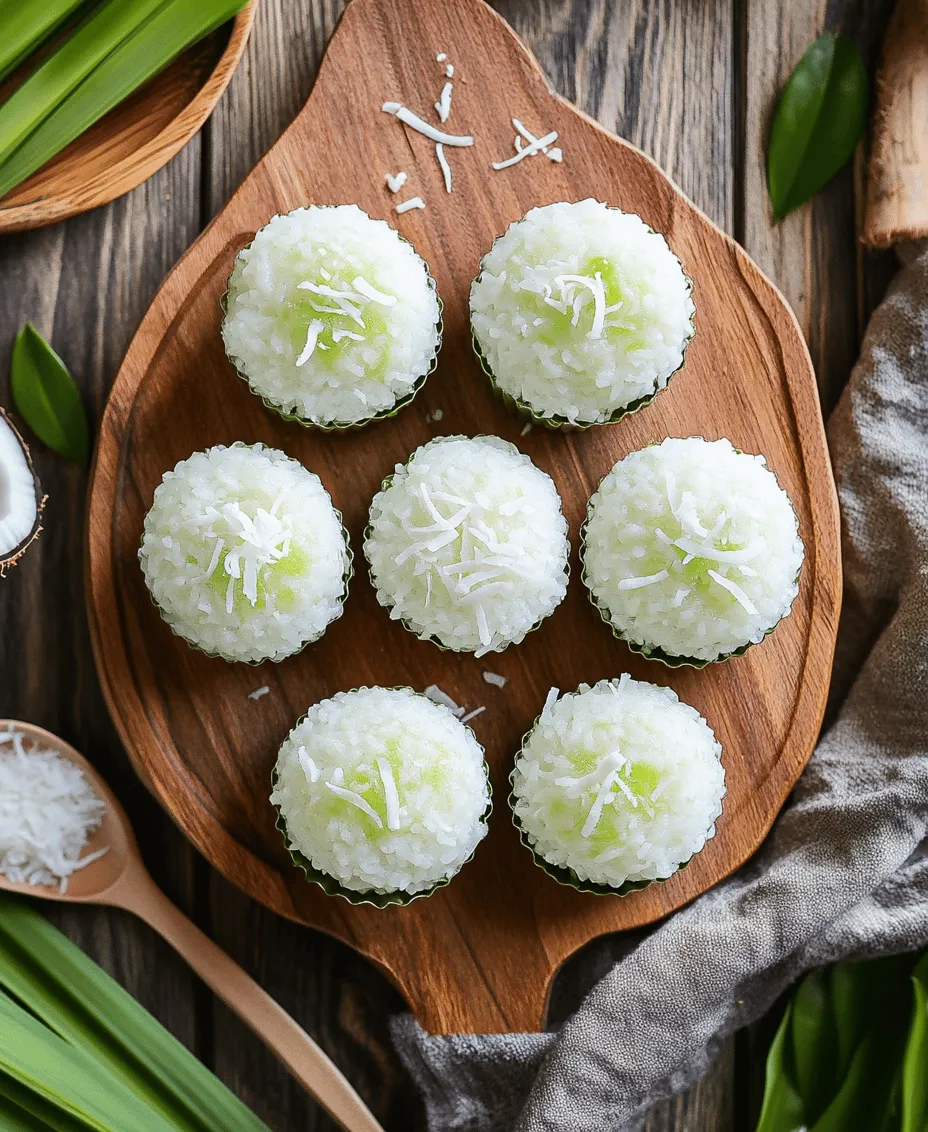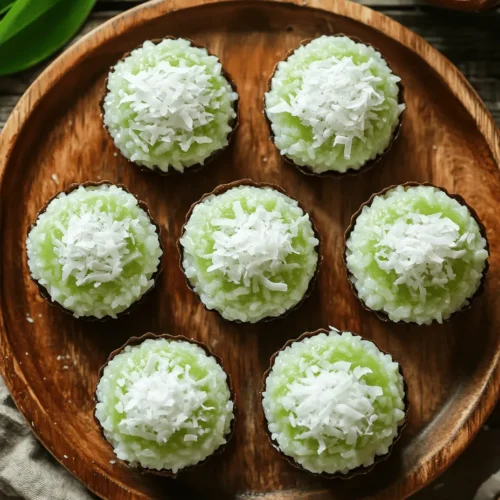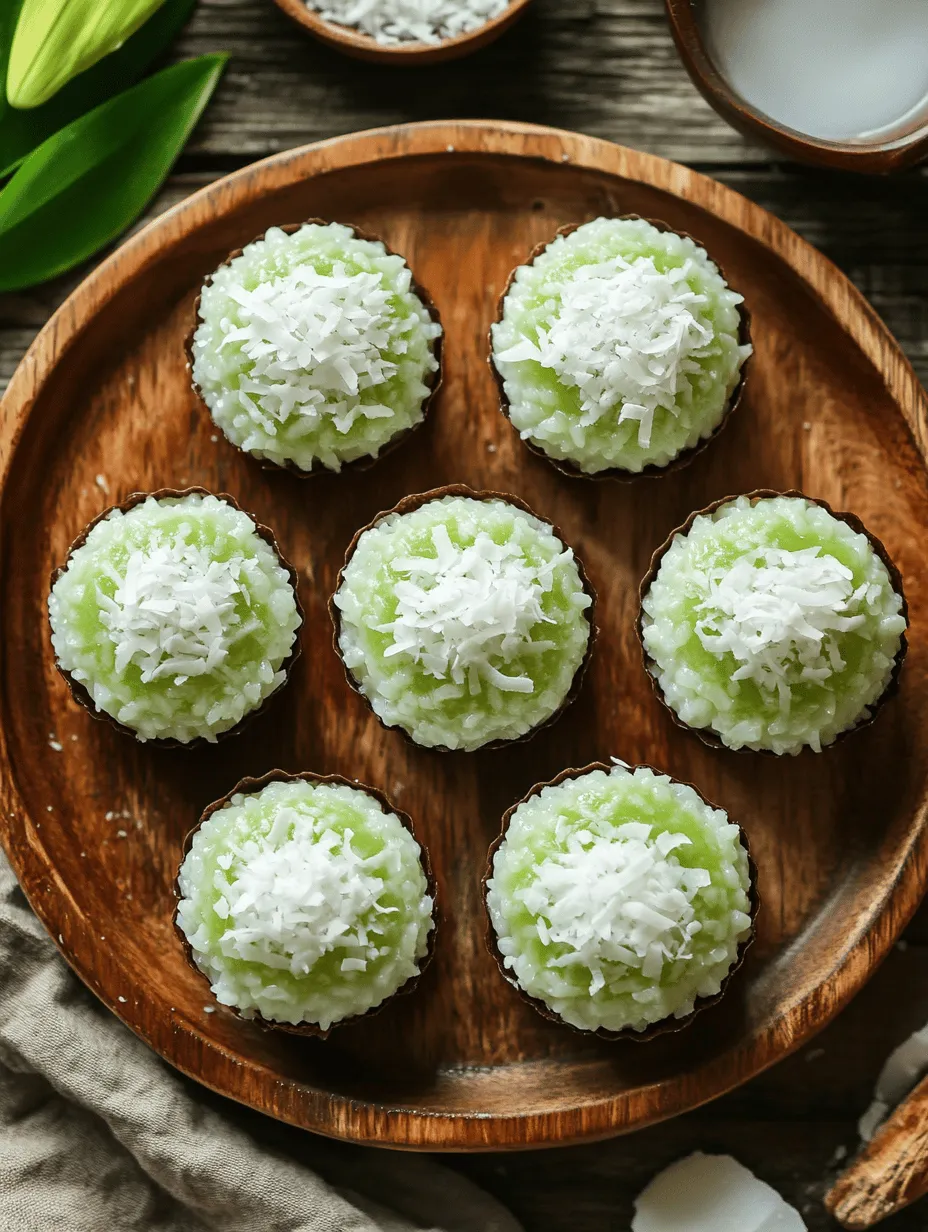Introduction to Coconut Rice Cakes
Coconut Rice Cakes are a delightful and versatile dish that can be enjoyed as a snack, dessert, or even a side dish. This recipe highlights the creamy texture and fragrant flavor of coconut milk combined with the aromatic qualities of jasmine rice. Originating from various regions in Southeast Asia, these rice cakes are not only a treat for the palate but also a connection to the rich culinary heritage of the area. They are often associated with festive occasions, family gatherings, and street food markets, making them a beloved staple in many households.
As you embark on this culinary journey, you’ll discover that Coconut Rice Cakes are surprisingly simple to prepare. The combination of ingredients brings a unique balance of flavors that can be customized to suit your preferences. Whether you’re looking to delve into traditional Southeast Asian cuisine or simply want to indulge in a sweet treat, these rice cakes are sure to impress.
In this article, we will explore the ingredients needed, the step-by-step preparation guide, and the cultural significance of this dish, ensuring that you have all the information you need to create the perfect Coconut Rice Cakes at home.
Understanding Coconut Rice Cakes
What Are Coconut Rice Cakes?
Coconut Rice Cakes are small, soft, and chewy cakes made from a mixture of jasmine rice, coconut milk, sugar, and shredded coconut. They are often steamed to achieve their signature texture, which is slightly dense yet tender. The cakes can be served plain or topped with additional coconut, and they can also be enjoyed warm or at room temperature.
One of the fascinating aspects of Coconut Rice Cakes is their regional variations. In Thailand, for example, they are known as “Khanom Krok,” often served with a variety of toppings such as sweet corn or green onions. In Vietnam, they might be found as “Bánh Bò Nướng,” which are baked versions that sometimes include pandan flavoring. Each variation reflects the local ingredients and culinary traditions, showcasing the adaptability of this dish across cultures.
The Appeal of Coconut and Jasmine Rice
Coconut milk is the star ingredient in this recipe, providing not only a rich and creamy texture but also a distinct flavor that elevates the rice cakes. Nutritionally, coconut milk is a source of healthy fats, particularly medium-chain triglycerides (MCTs), which are known for their potential health benefits, including improved energy levels and metabolism. Additionally, coconut milk contains vitamins C, E, and several B vitamins, making it a nutritious addition to your diet.
Jasmine rice, on the other hand, is known for its fragrant aroma and slightly nutty flavor. This long-grain rice is a staple in many Asian cuisines and is prized for its ability to absorb flavors while retaining its fluffy texture. When combined with coconut milk, jasmine rice creates a harmonious blend that is both comforting and satisfying. Its delicate flavor makes it an ideal base for the sweet notes of sugar and the richness of shredded coconut.
Ingredients Breakdown
Key Ingredients and Their Roles
To create the perfect Coconut Rice Cakes, it’s essential to understand the role each ingredient plays in the overall flavor and texture of the dish.
– Jasmine Rice: This is the foundation of the dish, providing the necessary texture and flavor. The long grains of jasmine rice absorb the coconut milk beautifully, resulting in a creamy cake that melts in your mouth.
– Coconut Milk: This ingredient adds richness and creaminess to the rice cakes, infusing them with a delightful coconut flavor. The quality of the coconut milk can significantly impact the final taste, so it’s important to choose a good brand.
– Sugar: While the coconut milk contributes some natural sweetness, additional sugar is needed to balance the flavors. The sweetness enhances the overall experience of the rice cakes, making them a delightful dessert.
– Shredded Coconut: This ingredient adds both texture and an intensified coconut flavor to the cakes. Unsweetened shredded coconut is preferred to avoid making the cakes overly sweet.
– Optional Ingredients: You can enhance the flavor profile of your Coconut Rice Cakes with pandan extract or vanilla extract. Pandan, often referred to as the “vanilla of Southeast Asia,” adds a unique fragrance and color, while vanilla enhances the overall sweetness.
Choosing the Right Ingredients
Selecting high-quality ingredients is crucial for the success of your Coconut Rice Cakes. Here are some tips to ensure you’re using the best components:
– Jasmine Rice: Look for authentic Thai jasmine rice, which is often labeled as “Thai Hom Mali Rice.” It should have a pleasant aroma and a slightly sticky texture when cooked.
– Coconut Milk: Opt for full-fat coconut milk for a richer flavor. Brands like Chaokoh and Aroy-D are well-regarded for their quality and consistency. Be sure to check the label for additives—choose coconut milk with minimal ingredients for the best results.
– Unsweetened Shredded Coconut: Make sure to use unsweetened shredded coconut to maintain a balanced sweetness in your rice cakes. You can find it in most grocery stores or health food shops.
Step-by-Step Preparation Guide
Preparing the Rice
The first step in making Coconut Rice Cakes involves preparing the jasmine rice. Rinsing the rice is essential, as it helps to remove excess starch, which can lead to overly sticky or gummy rice cakes. Here’s how to do it:
1. Measure the Rice: Start by measuring out the desired amount of jasmine rice. Typically, 1 cup of rice will yield a sufficient quantity for a small batch of rice cakes.
2. Rinse the Rice: Place the measured rice in a fine-mesh strainer or bowl. Rinse it under cold running water, gently swishing the rice with your fingers. This process helps to wash away surface starch and impurities.
3. Repeat: Continue rinsing the rice until the water runs clear. This may take several rinses, but it’s worth the effort as it ensures a better texture in your final dish.
4. Soaking (Optional): Some recipes recommend soaking jasmine rice for about 30 minutes before cooking. This step can help the grains absorb water and soften, resulting in a more tender texture.
Cooking the Rice Mixture
Once the rice is prepared, the next step involves cooking it with coconut milk and sugar to create a rich mixture:
1. Combine Ingredients: In a medium saucepan, combine the rinsed jasmine rice, coconut milk, and sugar. Stir well to ensure the sugar is dissolved and evenly distributed.
2. Add Water: Depending on the desired texture and the type of jasmine rice used, you may need to add a bit of water. A general rule of thumb is to use a 1:1 ratio of rice to coconut milk, with a little extra water if you prefer a softer cake.
3. Cook on Low Heat: Place the saucepan over low to medium heat and cover it with a lid. Allow the rice mixture to simmer gently, stirring occasionally to prevent sticking. The goal is to cook the rice until it absorbs the coconut milk and becomes tender, usually around 15-20 minutes.
4. Check the Texture: After the cooking time, check the texture of the rice. It should be soft and fluffy, with minimal liquid remaining. If it seems too dry, you can add a splash more coconut milk or water and continue cooking for a few extra minutes.
As you progress through these steps, you’ll find that the aroma of coconut and jasmine rice begins to fill your kitchen, setting the stage for the delightful Coconut Rice Cakes to come. Stay tuned for the following sections where we will cover the rest of the preparation process, including shaping and steaming the rice cakes, as well as some valuable tips for achieving the best results.

Importance of Simmering and Covering
Simmering is a crucial step in preparing coconut rice cakes. This method allows the rice to absorb moisture gradually, ensuring that each grain becomes tender and fluffy. When you cover the pot during this process, it traps the steam, which helps cook the rice evenly and prevents it from drying out. This is particularly important for recipes that rely on the rice’s natural starches to provide a creamy texture, such as our coconut rice cakes.
To achieve the best results, bring the mixture to a gentle simmer and reduce the heat to low. Cover the pot with a tight-fitting lid and let it cook undisturbed for about 15-20 minutes. This way, the rice can soak in the coconut milk and sugar, creating a rich and flavorful base for your cakes.
Flavoring the Rice
While the basic coconut flavor is delightful on its own, there are several techniques to elevate your coconut rice cakes with additional flavors. One popular method is to infuse the rice with aromatic ingredients during the cooking process.
For instance, adding a couple of crushed pandan leaves to the pot while simmering can significantly enhance the aroma and color of your rice. Pandan extract, derived from the leaves of the pandan plant, contributes a sweet, floral scent that complements the coconut beautifully. If you prefer a more pronounced flavor, consider using a few drops of pandan extract after cooking, stirring it gently into the mixture before molding.
Another technique is to incorporate spices like cardamom or a pinch of salt, which can help balance the sweetness and add depth to the overall flavor profile. Vanilla extract is also a fantastic addition for those who enjoy a hint of sweetness.
Molding and Steaming the Cakes
Preparing the molds for steaming is an essential step that will affect the final shape and texture of your coconut rice cakes. You can use traditional molds like small ramekins, muffin tins, or even banana leaves for a more authentic presentation. If you opt for metal or silicone molds, lightly grease them with coconut oil or cooking spray to prevent the rice cakes from sticking.
When it comes to filling and packing the rice mixture, it’s important to ensure that the mixture is evenly distributed and compacted. Use a spoon or spatula to press the rice down firmly into the molds, eliminating any air pockets. This will help the cakes hold their shape once steamed. Leave a bit of space at the top of each mold, as the rice cakes will expand slightly during cooking.
Steaming Techniques
For steaming your coconut rice cakes, you’ll need a steaming setup. This can be as simple as a large pot with a steaming rack or a bamboo steamer. If you’re using a pot, fill it with water, ensuring that the water level is below the bottom of the molds. Bring the water to a gentle boil before placing the molds inside.
Cover the pot with a lid to trap the steam effectively. The steaming process typically takes about 20-30 minutes, depending on the size of your molds. To determine if the cakes are properly cooked, insert a toothpick into the center of one cake. If it comes out clean, your coconut rice cakes are ready to be removed from the steamer.
Serving Suggestions
Presentation Ideas
Coconut rice cakes can be presented beautifully, making them a delightful addition to any table. For a simple yet elegant presentation, stack a few cakes on a serving platter and garnish with fresh herbs like mint or cilantro. A drizzle of coconut cream or a sprinkle of toasted sesame seeds can also enhance their visual appeal.
Pairing these cakes with sauces or toppings can elevate their flavor profile. A sweet coconut syrup, made by simmering coconut milk with sugar and a touch of salt, can be drizzled over the cakes, creating a luscious finish. Alternatively, consider serving them with a tangy mango or passion fruit sauce to balance the sweetness.
Cultural Context of Serving Coconut Rice Cakes
Coconut rice cakes hold a special place in various Southeast Asian cultures, often served during festive occasions and celebrations. In Thailand, for instance, they are commonly enjoyed during Buddhist festivals, while in Vietnam, they are a popular treat during the Lunar New Year.
Variations in presentation and accompanying dishes can differ across cultures. In some places, the cakes are served with savory dips or sides, while in others, they may be topped with fresh fruit or shredded coconut. Understanding these traditions can enhance your appreciation for this dish and inspire you to serve it in a way that honors its cultural significance.
Nutritional Information
Health Benefits of Coconut Rice Cakes
Coconut rice cakes are not only delicious but also provide several nutritional benefits. Each serving is rich in carbohydrates from the jasmine rice, which serves as a great energy source. The coconut milk adds healthy fats, particularly medium-chain triglycerides (MCTs), which are known for their potential to promote heart health and boost metabolism.
In addition to providing energy, coconut is high in dietary fiber, which can aid digestion and contribute to overall gut health. With the right balance of ingredients, these rice cakes can be a satisfying treat that nourishes the body.
Dietary Considerations
Coconut rice cakes are inherently gluten-free and can easily be made vegan-friendly, making them suitable for a variety of dietary needs. Ensure that all ingredients, especially the sugar and coconut milk, are labeled as vegan if serving to those with dietary restrictions.
For those looking to adapt the recipe further, consider using alternative sweeteners like maple syrup or agave nectar instead of traditional sugar. You can also experiment with different types of rice, such as brown rice for a nuttier flavor and added fiber.
Conclusion
Coconut Rice Cakes are more than just a tasty treat; they are a beautiful representation of the flavors and traditions of Southeast Asian cuisine. With their creamy texture and sweet coconut flavor, they are perfect for any occasion. By following this detailed recipe and understanding the cultural significance behind the dish, you can bring a piece of this culinary tradition into your kitchen. Whether enjoyed warm or at room temperature, these rice cakes are sure to be a hit with family and friends. Enjoy the journey of creating and savoring this delightful dish!



